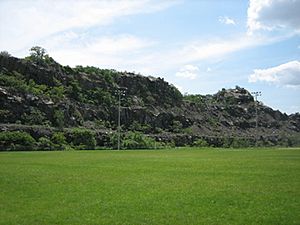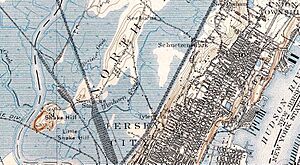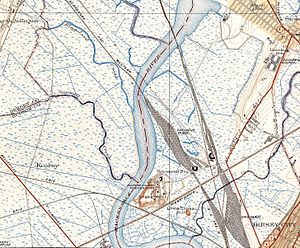Snake Hill facts for kids
Snake Hill, officially known as Laurel Hill, is a cool rock formation that sticks up from the ground in the New Jersey Meadowlands. It's located in southern Secaucus, New Jersey, right by a bend in the Hackensack River.
This hill was once much bigger! In the 1960s, parts of it were dug up for its rock, which was used to build things in nearby cities like Jersey City. Today, what's left of the hill is the main feature of Laurel Hill County Park. The highest point is about 203 feet (62 meters) tall and is covered in graffiti. It's a well-known sight for people driving on the New Jersey Turnpike, which goes right past its southern side. The top of the hill's unique, sloped ridge is about 150 feet (46 meters) high.
Contents
History of Snake Hill
Snake Hill was formed around 200 million years ago. It was created by the same underground melted rock (magma) that also made the famous Palisades cliffs.
Early Names and Owners
The first European settlers, who were Dutch colonists, called this tall bluff 'Slangenbergh'. This means 'Snakes Mountain' in English, because they found many snakes there.
Later, in the 1600s, the land around Snake Hill was bought and sold several times. Eventually, a man named William Pinhorne owned a large part of it, including Snake Hill itself. He even called the area where he lived 'Mount Pinhorne'.
Institutions on the Hill
For over a hundred years, from 1855 to 1962, Snake Hill was home to many important buildings for Hudson County. It was almost like a small, self-contained town! Hundreds of people lived there. The area had its own water system, power plant, and even a way to deal with waste.
These buildings included places that helped people, such as:
- Two almshouses, which were shelters for people who were poor or elderly.
- A penitentiary (a jail).
- A quarry where rock was dug up.
- Several medical facilities.
One of the medical places was a hospital for people with mental health challenges, which opened in 1873. At first, it could hold 140 patients. Different parts of the hospital were for men and women. Sometimes, people who were not mentally ill were admitted if their families could no longer care for them. It was easier to be admitted than to leave the hospital. Many people who passed away at these institutions were buried in a special burial ground on the property.
In the 1930s, the hospital's name was changed to the Mental Disease Hospital, to sound less harsh. By 1939, this hospital moved to a new location in Secaucus, which is now Meadowview Psychiatric Hospital. Over 1,800 patients were moved to the new hospital.
Quarrying and Changes
People continued to dig up rock from Snake Hill from the late 1800s until the 1950s. A part of the land was even used as a prison quarry. After a while, many of the buildings were left empty and started to fall apart. A lot of the hill was also leveled to make way for parts of the New Jersey Turnpike. In 1962, Hudson County finally closed all its facilities on the site.
In 2003, a large number of burial sites were found on the grounds. These were the remains of people who had lived or passed away at the old institutions. They were moved to allow for the construction of a new highway ramp for Secaucus Junction. Today, only one of the old almshouses is still standing on the property.
New Name: Laurel Hill
The name of Snake Hill was changed to Laurel Hill in 1926. A local official named Katherine Whelan Brown said it was the "crowning Laurel of Hudson County." She felt this way because the hill stands out so much in the flat meadowlands around it.
The high bluff has also been called 'Fraternity Rock' because of the Greek letters painted on it, likely by college fraternities. It's also known as 'Graffiti Rock' due to the artwork on its sides.
Laurel Hill County Park
Today, Snake Hill and the land between it and the Hackensack River are part of Laurel Hill County Park. This park is a part of the Hudson County Park System.
The park is home to the Hackensack Riverkeeper's Field Office and Paddling Center. This center is open on weekends from April to October and by appointment on weekdays. The Hackensack Riverkeeper also offers many boat tours (Eco-Cruises) from this park. There is also a narrow Ridge Trail that runs along the top of the hill, offering great views.
Field Station: Dinosaurs
Field Station: Dinosaurs, an exciting exhibit with moving (animatronic) dinosaurs, opened here in May 2012. The exhibit used the natural hills and valleys to make it feel like a prehistoric world. In 2015, the exhibit moved to a new location in Bergen County.
High Tech High School
High Tech High School, which used to be in North Bergen, built a brand new campus on the north side of the hill. Students started using this new campus for the 2018-2019 school year.
Geology of Snake Hill
The rock that makes up Snake Hill is called diabase. It's like a pipe-shaped intrusion of rock that came up from deep underground. Scientists believe it's connected to the nearby Palisades Sill, another large rock formation. You can see different types of rocks, like shales and sandstones, where the diabase pushed its way through.

A special mineral called Petersite-(Y) was found at Snake Hill in June 1981 by Nicholas Facciolla. In 1982, this mineral was officially recognized as a new discovery! It was named after Thomas A. Peters and Joseph Peters, who were curators (people who take care of collections) of minerals at museums in Paterson, New Jersey, and New York City.
Culture and Inspiration
Snake Hill has quietly inspired some interesting things. It's said that in the 1890s, an advertising executive from New York City saw the hill from a train. This view supposedly gave him the idea for the famous "Rock of Gibraltar" logo used by Prudential Financial. The hill's rugged look also appears in a 1968 artwork by artist Robert Smithson called Untitled (6 Stops on a Section).





